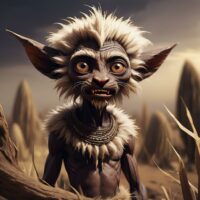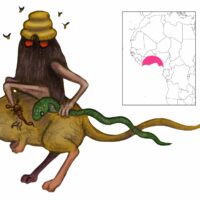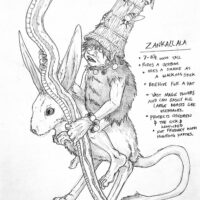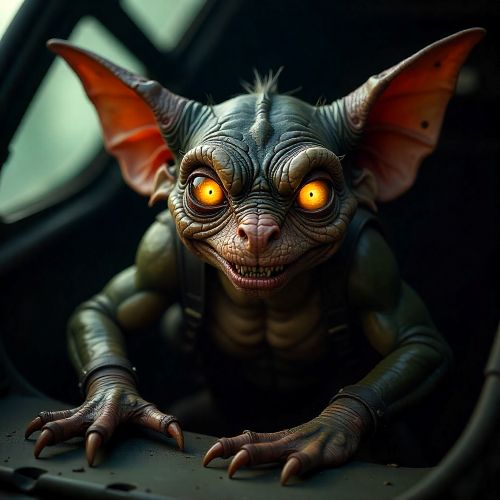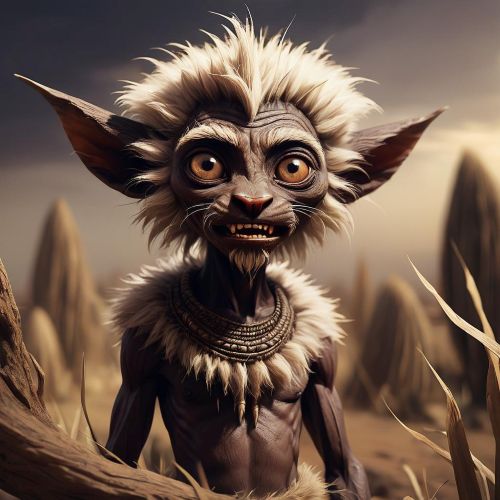
Zankallala : The Tiny Monster
Listen
At a glance
| Description | |
|---|---|
| Origin | Hausa Mythology |
| Classification | Hybrids |
| Family Members | N/A |
| Region | Nigeria, Niger |
| Associated With | Strength, Hearing, Endurance |
Zankallala
Introduction
Zankallala is a captivating figure rooted in the rich oral traditions of the Hausa people of Northern Nigeria and parts of West Africa. Though barely larger than two clenched fists, this mythological creature commands awe and reverence through its extraordinary might and cunning. Within Hausa storytelling, Zankallala is more than just a fantastical being—it represents the triumph of wit and resilience over brute strength. The creature’s tales are woven with lessons of courage, survival, and the wisdom of nature, serving as a cultural compass for generations.
Physical Traits
Despite its small size, Zankallala is anything but ordinary. It possesses a furry body, typically in shades of dark brown or black, which enables it to blend into the arid environments it often roams. Its exaggerated physical features—large ears, sharp claws, and an agile frame—equip it for survival and combat in the wild. But it’s the creature’s accessories that make it truly distinctive: a snake coiled like a cane for support and intimidation, scorpions worn like spurs to ward off enemies, and a crown of bees buzzing furiously atop its head, acting as both armor and weapon. Often seen riding a jerboa, a nimble desert rodent, Zankallala moves swiftly through sand and brush alike, its very presence an unsettling mix of whimsy and menace.
Family
Unlike many mythical beings whose stories revolve around dynasties or divine families, Zankallala stands alone. It doesn’t belong to any known pantheon or mythological bloodline in Hausa lore. Its solitude only enhances its mystique—emphasizing its role as a solitary guardian and trickster who appears in times of crisis. Without kin, it operates as a self-sufficient force, answering only to the call of justice or the thrill of conflict. This lack of familial backstory positions Zankallala as a symbol of independence and self-reliance, key virtues in the traditional Hausa worldview.
Other names
While “Zankallala” remains the most recognized name within Hausa oral tradition, some storytellers suggest that similar creatures with varying names might appear in other regional tales. Occasionally, creatures such as centipedes, hedgehogs, or other small animals take Zankallala’s place in retellings, reflecting local interpretations and symbolic needs. In some variants, characters like Kadindi, Kaddodi, and Kadda make appearances as allies or foes in similar narrative arcs. Despite these variations, the essence of Zankallala—a small being wielding enormous power—remains unmistakably unique to Hausa storytelling.
Powers and Abilities
The heart of Zankallala’s legend lies in its astonishing abilities. Though physically unimposing, the creature boasts powers that surpass even the mightiest of adversaries. One of its most iconic exploits involves defeating the dreaded Dodo—a monstrous, man-eating being known as the “Swallower-of-Men.” Zankallala’s victory over Dodo is not through brute force but through relentless cunning: it allows itself to be eaten multiple times, only to escape from different parts of the monster’s body, ultimately killing it from within.
Beyond this legendary battle, Zankallala is believed to manipulate elements of nature to its advantage. It can summon sandstorms to obscure itself from predators or enemies, and its control over the wind aids in rapid movement across vast deserts. The birds that follow it act not just as companions but as an aerial defense system, swarming enemies at Zankallala’s command. Its heightened senses, particularly its acute hearing, make it a master of evasion and stealth. The creature is also an expert in mimicry and shape-shifting, allowing it to blend into its environment or take on deceptive forms when needed.
Modern Day Influence
While still largely rooted in the traditional narratives of Hausa communities, Zankallala has slowly begun to seep into modern cultural consciousness. Its image has appeared—though loosely interpreted—in video games such as Path of Exile, where a small but menacing creature is named after it. This digital appearance has sparked curiosity about its origins, leading global audiences to explore Hausa folklore.
In African fantasy literature and artwork, Zankallala’s symbolic resonance as a representation of the underdog triumphing against overwhelming odds has made it an appealing figure. Independent artists have rendered it in comics, concept art, and short stories, often drawing inspiration from its signature elements like the bee hat and scorpion spurs. Educational institutions exploring African oral history also use the story of Zankallala to highlight indigenous storytelling methods and cultural resilience.
Within Hausa communities, however, Zankallala remains more than a mythical figure—it’s a cultural icon. Elders continue to tell its stories to teach values like cleverness, bravery, and the importance of humility. The legend also features in children’s fables, sometimes simplified to reflect everyday challenges that require intelligence over strength. In this way, Zankallala continues to serve as both entertainment and moral instruction.
Related Images
Source
Smith, John. African Mythology: Legends and Creatures. Oxford University Press, 1998.
Adewale, Tunde. Hausa Folklore and Mythical Beasts. Lagos Publishing House, 2005.
Contributors to Wikimedia projects. (n.d.). West African mythology – Wikipedia. https://en.wikipedia.org/wiki/West_African_mythology
abookofcreatures. (2021). Zankallala | A Book of Creatures. https://abookofcreatures.com/2021/05/07/zankallala/
mythicalencyclopediaadmin. (2024). Zankallala: Mythical Creature Overview – Mythical Encyclopedia. https://mythicalencyclopedia.com/zankallala/
Frequently Asked Questions
What is lorem Ipsum?
I am text block. Click edit button to change this text. Lorem ipsum dolor sit amet, consectetur adipiscing elit. Ut elit tellus, luctus nec ullamcorper mattis, pulvinar dapibus leo.
What is lorem Ipsum?
I am text block. Click edit button to change this text. Lorem ipsum dolor sit amet, consectetur adipiscing elit. Ut elit tellus, luctus nec ullamcorper mattis, pulvinar dapibus leo.
What is lorem Ipsum?
I am text block. Click edit button to change this text. Lorem ipsum dolor sit amet, consectetur adipiscing elit. Ut elit tellus, luctus nec ullamcorper mattis, pulvinar dapibus leo.
What is lorem Ipsum?
I am text block. Click edit button to change this text. Lorem ipsum dolor sit amet, consectetur adipiscing elit. Ut elit tellus, luctus nec ullamcorper mattis, pulvinar dapibus leo.
What is lorem Ipsum?
I am text block. Click edit button to change this text. Lorem ipsum dolor sit amet, consectetur adipiscing elit. Ut elit tellus, luctus nec ullamcorper mattis, pulvinar dapibus leo.


